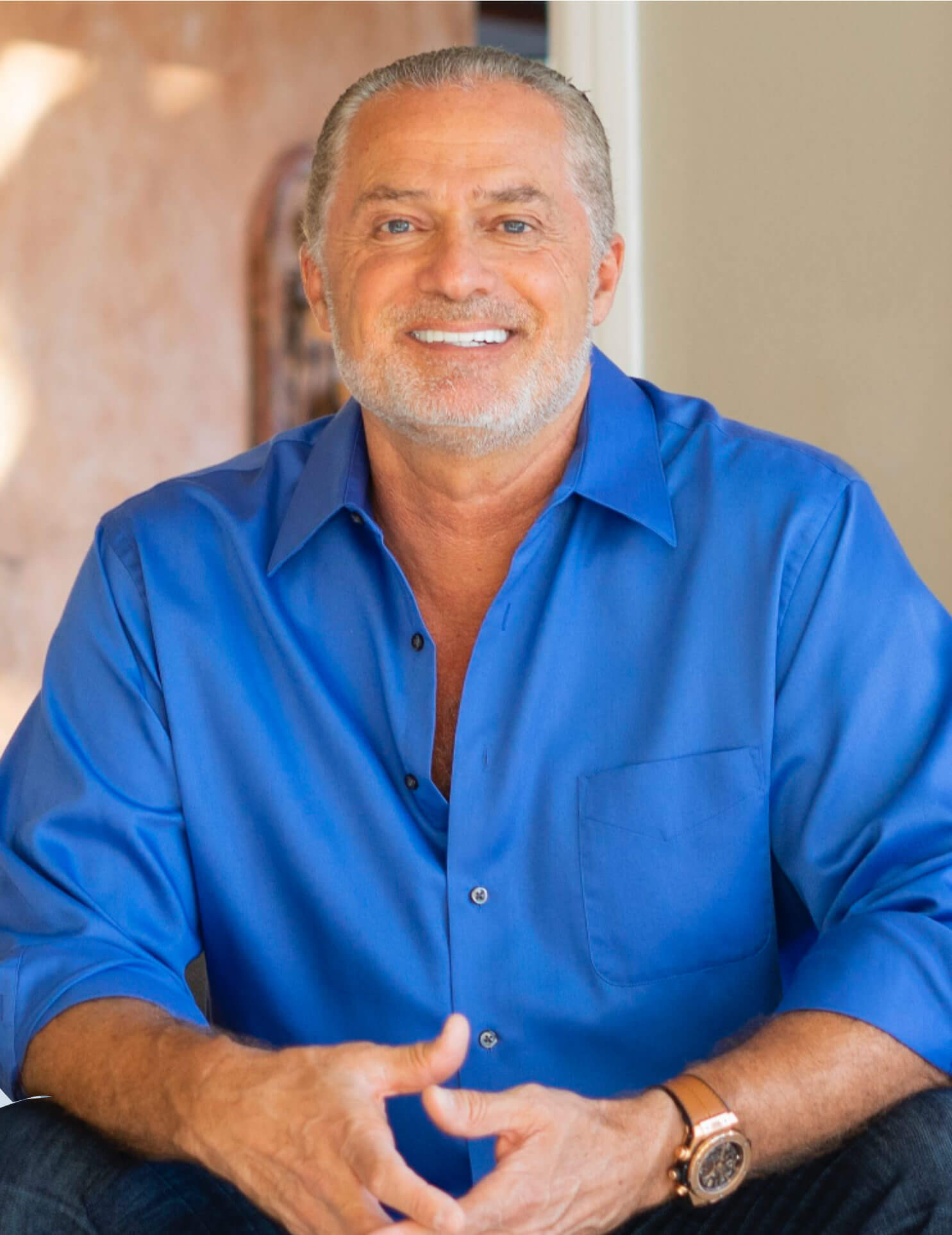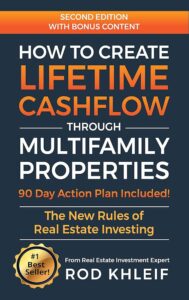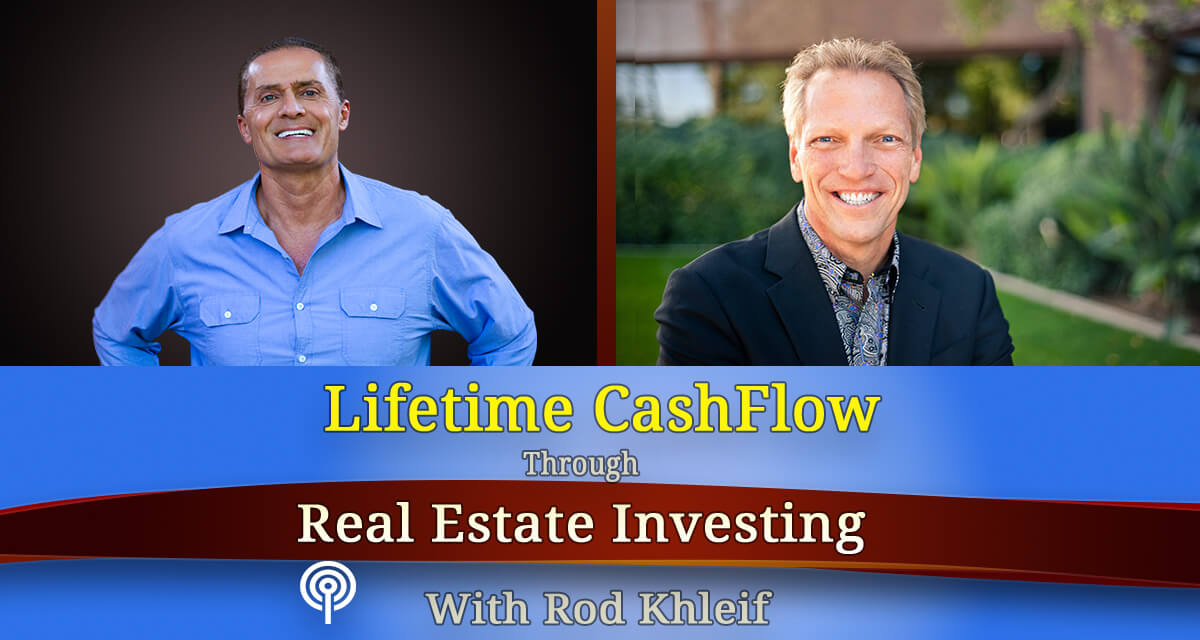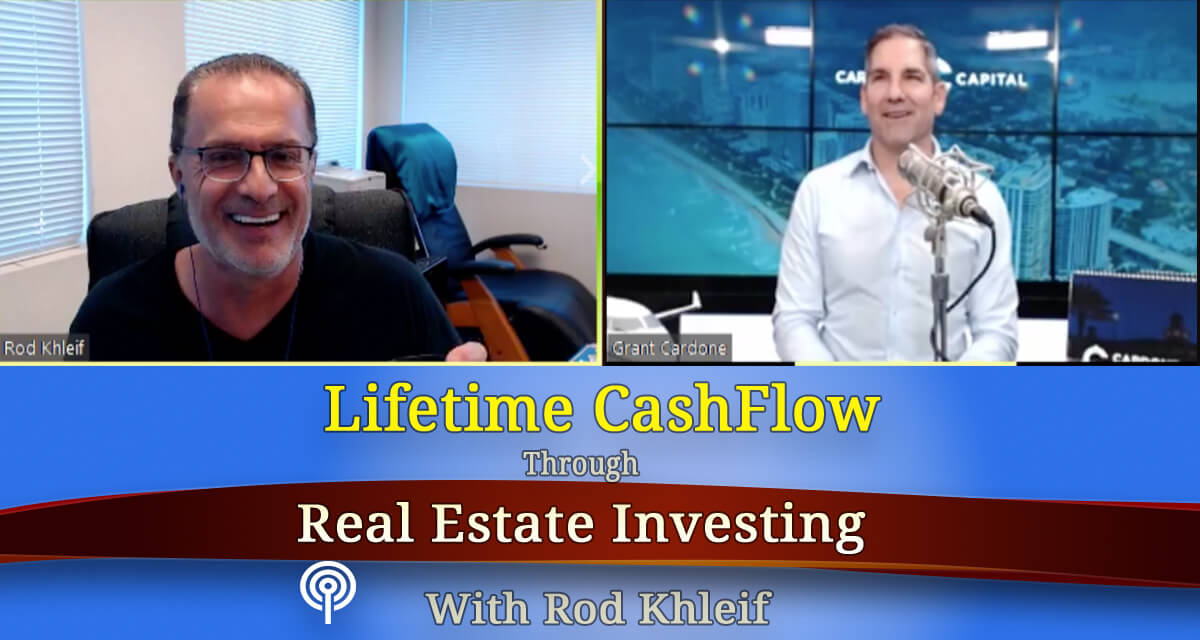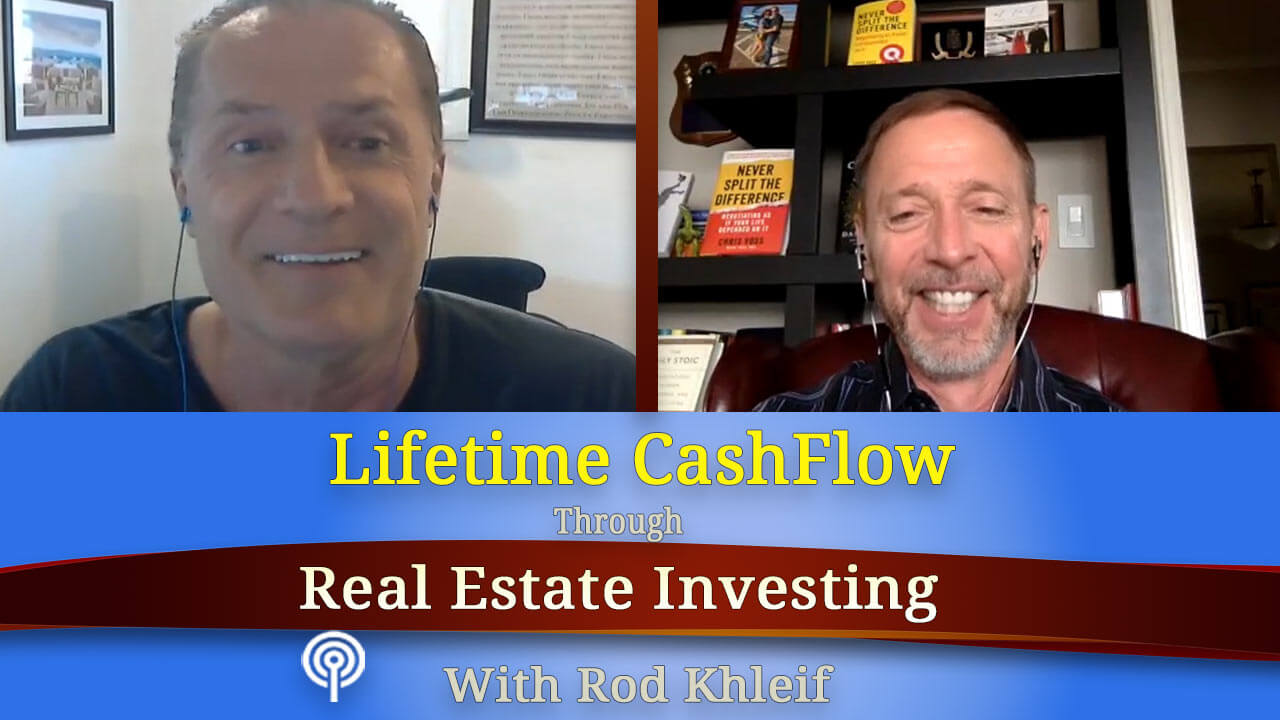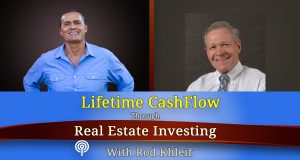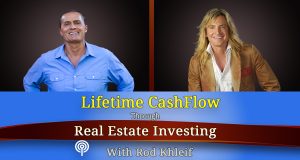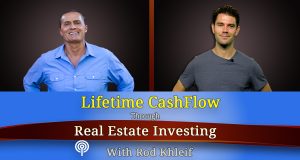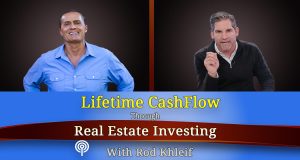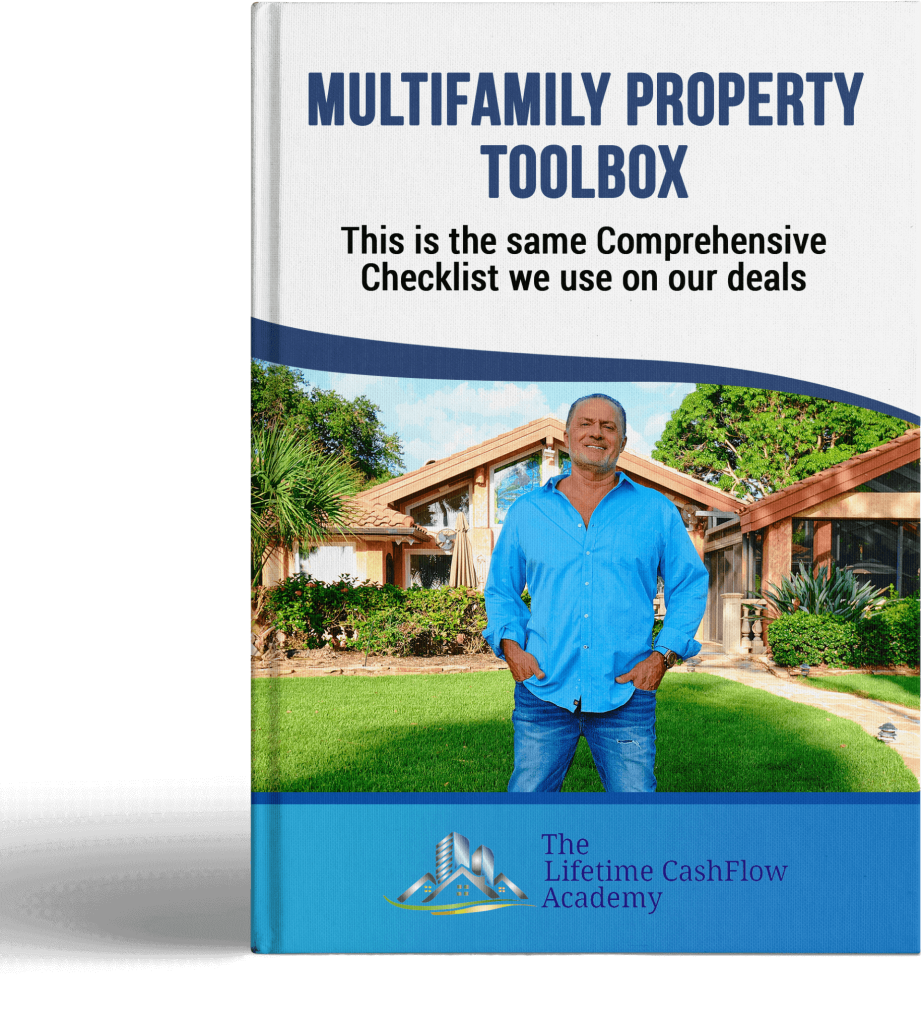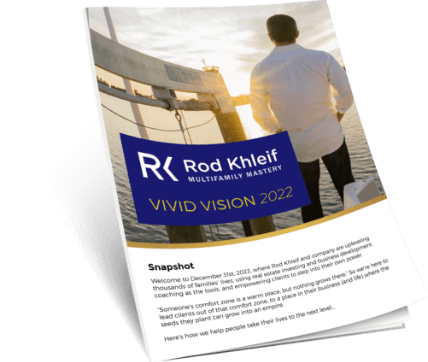Ep #459 – Yakov Smart – Raising capital on LinkedIn
Social Media for Real Estate Entrepreneurs
- The issue of trust
- Identifying your “list”
- Optimising your page, content and messaging
- 3 Profile mistakes to avoid
- Give value first
- Trust first, features second
- Content visibility and credibility
- 3 X 3 X 3 content strategy
To find out more about our guest, click here.
Full Transcript Below
Ep #459 – Yakov Smart – Raising Capital for Real Estate on LinkedIn
Rod: Welcome to another edition of How to Build Lifetime Cashflow through Real Estate Investing. I’m Rod Khleif and I am thrilled you’re here. And we have an unusual guest on the show today and i’ll say unusual because usually I’ve got multi-family operators that have hundreds or thousands of doors on but today we’ve got a gentleman named Yakov Smart. And he is an expert in maximizing LinkedIn and really in utilizing that platform to create reach and tap into potential investors to invest in your deals. And I thought you know you’ve heard me talk on this show time and time again how you have to create reach and you have to find a channel for that reach be it a podcast like I’ve done or Youtube or Instagram. Well here we are with LinkedIn. So without further ado, Yakov, welcome to the show brother!
Yakov: Hey great to be here! Thank you for having me.
Rod: Absolutely. So let’s talk about your experience as it relates to LinkedIn and some of the things you’ve done and then we’ll drill down on some details. So please kind of share a little bit of your story
Yakov: Yeah absolutely. So I always start my story in a bit of an unusual place because I’ve been on social media pretty much my whole life. I mean I’m in the generation that grew up with social media. I’ve been on social media since the eighth grade and I got my start on Myspace, using Myspace to try
Rod: Oh Myspace wow yeah wow okay
Yakov: That’s where I started on social media and I’ve always been fascinated with marketing and online how things work and I started my first online business as a college student. I wrote an eBook on how to succeed in college and I started to learn how to market that online. So I’ve been in the online marketing space for a considerable amount of time. And the way I got onto LinkedIn was, I was working a job selling software and software sales and for me it was a big thing to reach the decision maker and try to book an appointment and unfortunately I was doing a lot of cold calling and it was just driving me crazy it just it wasn’t going too well. People weren’t picking up people were saying some not so nice things as anyone who’s ever cold called can probably know. So out of necessity really I turned to LinkedIn and I inadvertently discovered a new way of using LinkedIn to get more leads and meetings with prospects. And I was living in Vegas at the time. So I started working with local business owners out there on LinkedIn lead generation and then I authored the book, “Disrupting LinkedIn: Build a multiple six-figure business specifically around lead generation on LinkedIn”. And the way I got into working with mostly real estate entrepreneurs which at the time today this is most of the people I work with are either real estate entrepreneurs people doing syndications, people wanting to raise capital and attract high net worth investors and my first experience in that, I met a couple of gentlemen they were putting together something called a deal club and they were bringing together they wanted to bring together these high high net worth individuals, people worth hundreds of millions if not billions of dollars who were angels and they wanted to put them in a room with startup founders and they came to me and they said,
Rod: I’m sorry. They wanted to put them in a room with what? I misunderstood that last piece
Yakov: Yeah they want to put them in a room with people who were founders of companies
Rod: Gotcha okay
Yakov: And they were brokering the deal and they were making
Rod: Gotcha little piece of the deal, got it
Yakov: Yeah so they asked me if I thought it was possible to reach these really high net worth individuals on LinkedIn and get them to engage and build trust and get them to come to the deal club and I said that I did and we developed a system for reaching those types of people and that’s when I started to realize the world of raising capital the world of you know reaching those type of high net worth of fluent individuals on LinkedIn. And at around the same time you know I’ve had some people in the real estate space who were influencers reach out to me and you know I’ve done some things with other people in the space real estate entrepreneurs around making key contacts and raising capital to the point where today my biggest focus like I mentioned a moment ago is in working with syndicators and real estate entrepreneurs who want to attract what I call “A-list investors” who can invest in their projects
Rod: Okay okay. So the elephant in the room, how? Lay it on us okay don’t hold back okay the more you give the more you receive so give lavishly right now my friend. So how does somebody get going on LinkedIn?
Yakov: So let me give you speaking of elephants in the room let me give you the big problem that a lot of syndicators have if they want to raise capital online or on LinkedIn and that big problem is trust right. I mean because what a lot of people under don’t understand it’s a one thing to network in person and talk to somebody in person versus online. They don’t know you from right and so to get that person to trust you and that’s the majority of my focus in terms of messaging in the actual system is, how can you accelerate trust? how can you build trust with that individual who doesn’t know you yet to the point where they’ve raised their hand and expressed interest saying, okay this is interesting I want to find out more about this right. So here’s the methodology and I can go into as many specifics and details
Rod: Let’s drill down on this man this is exciting and we’ll give people you know um access to how they reach you if they want to go deeper. But let’s add some value today. So I suppose it starts with your page, yes? It starts with having a credible what do you call it home page or what do you call it on LinkedIn? I don’t know what it’s called
Yakov: LinkedIn profile and there’s a step before that’s, that a lot of people overlook. So I’m glad you brought that up right
Rod: Let’s go step by step please. The first step is it starts with your list okay. It starts with figuring out who’s this for right because your page and your messaging and everything you do is going to be very different if for example you want to attract college professors to invest with you versus tech founders right? They see credibility differently you build trust differently. So in my methodology I talk about magnetizing for your list so
Rod: And by the way another word for list would be your avatar, who’s your, who’s the person you’re going after like for me, in my thought leadership business, it’s an analytical person, typically engineering or I.T background you know I have a lot of women but probably 80 of them are males from 35 to 52 or 53. So how tight do you break down the list? Let’s talk about that
Yakov: So on LinkedIn there’s a number of different variables you can use. I tell people to get as specific as possible because online you have a split second to grab people’s attention. So if you can get that specific if you can say we want engineers or you know a lot of my students they for example want people working at Google at Amazon and Project Management. You can identify those people on LinkedIn and have a list but what’s as important as building that list using LinkedIn is also understanding how do those people communicate? What’s valuable in their eyes? And based around that list magnetizing your messaging which is the second component which is accelerating trust okay which is
Rod: Okay just hold on if you don’t mind before we go to that step. So talk about some of the metrics inside of LinkedIn that you can search under or you can just just let’s go just a little once one step deeper before we move on to the magnetization here
Yakov: Yep absolutely so in the magnetization the list building you can search so there’s the free search which is pretty powerful and prolific as it is and then the sales navigator search for people that want to get. Inside a sales navigator there’s about 15 different filters in there, constantly adding. But you can get, you can for example target a zip code. So if you know there’s an affluent zip code in your area and you want people within 10 miles of that zip code. It’s an angle right all these are different angles all these are different variations. So I want people to put the data like that okay. So you’ve got your list building angles. So you’ve got your geographies one, experience working at a company is another one right, so if somebody’s been at a company for a certain amount of time they’re more likely to have a retirement account for example another angle right. Another piece is their level of seniority at a company. So you can have for example somebody who’s a manager level, somebody who’s a VP level, somebody who’s the C-level right. So it’s different audiences then some other filters out there you can actually go by interest in different groups. So it’s one thing to find Dentists right, it’s another thing to find dentists who are interested in real estate investing, two but potentially very different people so that’s the edge you want to really get in on behavior right. A couple other filters out there you have for example you know if you’re looking for military, you can find people that are serving in the military or have served in the military for instance right. And a few more that are available back there is also you know somebody’s years at a current company right. So how long you know they’ve been at the company and what company size they’re at right because especially if you’re drilling down on corporate employees you know there’s, you can look at people at companies with 10,000+ employees, you can look at people at small businesses. So there’s those different types of variables. Does that answer your question Rod?
Rod: Yeah I assume you don’t have income because that’s really not a question inside of LinkedIn. Do you have age? Does age come into play?
Yakov: The way to do age is years of experience
Rod: Okay okay. So that’s how you get around it okay all right yeah because LinkedIn honestly is really I think was driven by connecting employers with employees correct? And so maybe that ties into the whole hey you can’t ask somebody how old they are when you’re interviewing for, I don’t know, I’m just spitballing here okay. So the next step was magnetizing something or other please continue
Yakov: We talked about magnetizing list right. So it’s thinking about and I’m big on, you mentioned engineering, I’m big on reverse engineering a process right. So the outcome that people are wanting to accomplish here is get that investor to raise their hand, have a conversation, invest in your deals okay, and then tell their friends about it obviously. So it’s reverse engineering, what’s the approach going to be? So the next piece is accelerating trust there’s three core components of LinkedIn messaging that we can get into here. First one I mentioned a few minutes ago we’ll talk about each one separately okay. First one is the LinkedIn page, LinkedIn profile, and that’s a personal LinkedIn profile okay. And I’ll come back to it in a second. The next one is LinkedIn content. So what you’re posting on LinkedIn and the third piece is what I call a LinkedIn messenger funnel
Rod: Okay so you said LinkedIn content, you’re breaking up just a tiny bit so you might want to adjust your mic but the third one was LinkedIn what?
Yakov: LinkedIn messenger funnels
Rod: Messenger funnels, got it okay. Interesting. Okay well let’s drill down on those
Yakov: Awesome so the profile piece is, and can you hear me okay? I want to make sure my audio is better
Rod: Yeah I’ll let you know. I’ll let you know. I think we’re okay yep
Yakov: Okay cool so the LinkedIn profile right and what’s powerful about a LinkedIn profile is when someone googles your name just the way that LinkedIn is set up and the relationship LinkedIn has with SEO that profile is usually going to be among the top five results first page even you’re not doing a whole lot on LinkedIn. So there’s other benefits to having a really great LinkedIn profile. It’s the first impression okay. So it’s the first impression to get someone to decide whether or not they trust you or whether or not they don’t right. And it’s really important to make a powerful first impression. So there’s three mistakes that I see when it comes to LinkedIn profiles that a lot of people in this space in real estate make and they go in one of the three extremes and sometimes the combination. So the first one you know the old way of using LinkedIn was connecting employers with employees right. And it’s that resume platform. So there’s a lot of entrepreneurs out there where their profile still looks like a resume. They’ve got their executive bio they’ve got their experiences, specialties, and that’s fine if you’re looking for a job right. But if you’re wanting to attract investors there’s a whole different layer to it right. So I don’t encourage people to just have a corporate resume there because your investors need to know what’s in it for them right. I’m big on educating first. I’m big on giving value first. And until they understand what’s in it for them, they could care less about your corporate resume. So it’s a big mistake that I want people to avoid. The next type of you know mistake that I often see, I call it the wide-eyed squirrel okay. It’s like if somebody’s got five different businesses or five different projects all listed on their profiles right and that investor sees your that potential investor sees your profile, all of a sudden it looks like you’re you know this jack of all trades, master of none
Rod: Right right right okay
Yakov: So I see a lot of people doing that and now that’s not to say if you’ve got multiple businesses right. What I recommend to people is you know when you tell your story, you leave that in. So maybe you had an experience in one business and now you’re doing real estate syndication well what was it from that business that makes you credible right? You play that as an asset right
Rod: Nice nice
Yakov: That’s the second type of big mistake and the third piece is something that’s just over the top I call it 90s marketing brochure right. It’s when somebody is all about features and benefits first and features and benefits are great but you want to understand until they trust you until they care, they’re not ready to hear about the features and benefits yet.
Rod: That’s like the used car salesman, hey I don’t see you looking at this convertible. It doesn’t even build rapport, nothing. Yeah got it
Yakov: Exactly. So that’s a big issue. So instead of doing that and the approach that I recommend is you want people to feel understood. You do want to establish your authority and some ways to do that are to address what their frequently asked questions are, some of their key objections are in your profile. When you’re the one to address that, you show a different level of awareness and you want people to say this person gets me okay. And it’s also understanding that you wanna just like visually, this is online most people are scanning first. So you want to make sure that you’re putting two three sentences at a time at a time at most you’re not clumping into long paragraphs. Otherwise, it just becomes, people won’t read it right
Rod: So LinkedIn, LinkedIn is, the brevity is power on LinkedIn then two to three sentences interesting I didn’t know that okay
Yakov: Two to three, now that’s not the entire profile but there is a character limit right. So brevity in each
Rod: Oh we’re on the profile still I’m sorry. I was thinking posts okay
Yakov: We’ll get in to the posts in a second
Rod: Okay okay all right
Yakov: So on the profile piece it’s just breaking it up into these short paragraphs using symbols, having featured content so if you’ve been featured on podcast media definitely having that on your profile is important. Another thing
Rod: And where does that go? Where does that go in the profile featured content is there a place for it?
Yakov: There’s a section for it yep
Rod: Okay great okay okay great
Yakov: So the last thing that I’ll say about profiles is there’s a place to have your cover photo right so you’ve got your picture of your of yourself on LinkedIn. You’ve got your cover photo too right. So it’s important to have that cover photo stand out be aligned with your brand look really good look really sharp
Rod: Yeah I’m taking notes furiously because I probably, my picture probably still I started put probably still have dark hair you know no beard and definitely don’t have featured content in there. So this is good stuff. I hope you guys are taking notes as well. Okay so that’s it on the profile so now we’ll talk
Yakov: One other thing that I want to mention with that that’s a recent change to LinkedIn actually is LinkedIn business pages right. So we’ve been talking about personal pages, personal profiles, and that’s what you’re going to use to make contacts for potential investors. But your LinkedIn business page it’s important to have one because it adds more credibility and LinkedIn business pages right now without going down this rabbit hole too much are a lot like Facebook business pages for back 2011-2012 right where you know you could get a lot of organic exposure without having to pay-to-play on your content on this on your Facebook business page. That’s how LinkedIn business pages are right now too. So I recommend people, if they don’t, if you don’t have a LinkedIn business page definitely make one and it’s a great another place to syndicate content.
Rod: Okay all right. So now let’s go into, well where were we gonna go into next? Forgive me
Yakov: We were gonna go into content
Rod: Content. All right fantastic. So I’m dying to hear this. I think I know where you’re going to go with it but I’ve been wrong before. So, what kind of content do they want to see on LinkedIn or do you want to put on LinkedIn?
Yakov: So let’s start with some big misconceptions right because there’s a lot of gurus out there saying that you should be posting five times a day and that’s complete BS. I don’t recommend anybody do that right because that’s over doing it and it’s a lot of time and the upside for that isn’t that great right. So instead, you’re looking for three things with your content. You’re looking for relevance. So you want to make sure it’s relevant to that specific investor okay what again what’s in it for them. You’re looking for visibility and that’s understanding the algorithm understanding what post LinkedIn is going to put in front of people and you’re looking for credibility. You want content to ultimately move people towards trusting you more and move them towards wanting to find out more about working with you right or about investing in your project. So there’s a lot of different types of content on LinkedIn. Some big ones right now and this is evolving this is changing you know day by day pretty much because LinkedIn live is sort of coming out. I mean it’s coming out strong right now it’s being beta tested by a group of users but my prediction is you know here in the next six to 12 months everybody’s gonna have access to LinkedIn live. So you’re gonna be able to live stream and you know with that being said video is doing really well on LinkedIn right now video is getting about five times the exposure of other posts. So video is a great
Rod: So is the video actually recorded right on LinkedIn or do you do it on Youtube or Wistia or something like that and embed it
Yakov: To get more visibility you want to do native videos you want to upload it directly into LinkedIn
Rod: Upload it into LinkedIn. Got it okay. Well let’s go back because you blew through something that I’m not going to let you get away with here. We talked about relevance, visibility, and credibility. Can we drill down on those please?
Yakov: Absolutely. So what happens is when you connect with somebody on LinkedIn, LinkedIn has this, and no one knows how it works it’s super secret and I kid you not about this. This artificial intelligence algorithm right and some rocket scientists somewhere is working on this day by day. But basically its job is to say do these people care about each other? or what does this person care about? because the way that they make money, they make money a couple different ways. One of the ways they make money is by keeping you on the news feed longer because you see more ads, you’re more engaged, it generates revenue from them and Microsoft bought them a few years ago so they’ve sort of shifted the way they do content. They’ve shifted the platform in a lot of ways.
Rod: Monetize it effectively yeah right
Yakov: So when it comes to that relevancy piece right you know if you and I Rod, if we go and we connect on LinkedIn today and I post something, LinkedIn wants to know do you care? Do you care about what I’m posting right? So it’s going to be much more likely that it it’s going to put what I posted out in front of you because it want us to see if you and get this not just whether you like comment or share but this algorithm can see how many seconds you’re spending on looking at the post. If you stop scrolling, you’re on the post and say wait a minute, this guy cares. I’m gonna show this to him again okay.
Rod: Can I make an embarrassing confession? I don’t think I’ve ever responded to a comment on LinkedIn. I’m prolific on Facebook but I’ve like ignored LinkedIn. So this is why I’m fascinated by this conversation because I need to you know obviously change that because I’m certain even though you say you know facetime is important. I’m sure commenting and responding and all that certainly going to trigger that algorithm as well yes
Yakov: Absolutely so one thing I teach in our program is called three by three by three. And I’ll share it with you here it’s a really actionable thing that anyone can do whether they’ve been on LinkedIn for a while or they’re just starting out. So you take three minutes a day. You go through your newsfeed. There’s also a LinkedIn news you can do this too and different articles from influencers. There’s different ways to find content. You pick three pieces of content okay that are in the newsfeed. There are some that are relevant to you, that are relevant to your investor okay. And what you do, and because what’s great about LinkedIn, there’s a lot less engagement in general. There’s a lot less likes and comments than a place like Facebook right it’s more of a one-to-one platform in that sense. So all you’re gonna do is you’re gonna pick that post, you’re gonna take a quick look at that post, you’re gonna give it a like okay. And you’re gonna comment okay. And you’re gonna comment the first thing you’re gonna you’re not just gonna say great post okay even though that’s better than nothing. You’re gonna say good post insightful whatever you’re gonna acknowledge and then you’re gonna ask a question okay. So what happens when you do that? First of all you get that person’s attention. They’re probably gonna fall out of their chair because they’re not getting a ton of engagement as it is. So you’ve been to them like who’s engaging? And it’s much easier for them to respond it’s that conversation out in the open than even in the DM it feels a lot more public now their post is recirculating and LinkedIn is going to be saying, okay this person’s an active user. So then when you go and post something you’re going to have more favor with the algorithm.
Rod: Interesting. Okay got it. So that’s the three by three.
Yakov: Three by three by three
Rod: Okay got it okay. So relevance, we talked about relevance. I guess we talked about visibility as well a little bit as part of this
Yakov: What’s that?
Rod: Anything to add to relevance and visibility that we may have not touched on?
Yakov: Well visibility is a rabbit hole right because there’s a lot of, there’s sort of you know it’s a changing hierarchy of what LinkedIn is pushing out there like for example the time that we’re talking LinkedIn polls just came out right. So you can post a poll on LinkedIn and those are getting a lot of visibility because it’s a new feature. So a good rule of thumb new feature comes out, use it because LinkedIn rewards people using new features. What’s cool too is if you’re doing this from your personal profile, LinkedIn actually shows you the post. It actually shows you how many eyeballs you’ve got on your post from what you posted. And that’s your personal profile okay. So that’s included as well and what’s important about visibility and this is a nuance that I want people to understand right. If you’ve got a sophisticated investor, they’re not necessarily liking and commenting on a bunch of stuff on LinkedIn okay. They might not be the type of person they are. However, if they’re seeing it, you’re starting to create that omnipresence. So sometimes having somebody see something is a great touch point a great trigger even if they haven’t liked or commented. So don’t underestimate that
Rod: Okay okay which ties into credibility a little bit as well. What else can you drilling down on credibility? Is there anything else you would add there?
Yakov: Just being just being mindful of what they care about. I’m not big on, you know there’s content posting services out there used to be that would like pull content from online and just plop it up on LinkedIn or social media and that act usually doesn’t you know establish credibility because if your investor is savvy, they know that oh someone just did that for them there’s very little thought. So if you’re gonna share content have a little blurb around it right. Offer your insight. There’s something happening in the market there’s something trending you position yourself as the authority offer your bit of insight with that. Don’t just post things and leave it’s a chance
Rod: Okay all right. So what’s next?
Yakov: So next is the LinkedIn messenger funnel and this is where you have the ability to as a real estate entrepreneur to go out there and generate investor leads on your own terms and put yourself back in control. This is the ability to attract investors on demand. This is the ability to go out there that targeted list of potential investors to start building relationships from anywhere with people from anywhere in the world really as long as they’re on LinkedIn. And you can reach that decision maker directly on yourself okay. So first thing is you have, and there’s different automation tools available too but basically think about it as you know it’s more like a drip campaign on email but just through LinkedIn okay. So what that means when we talk about a funnel is you don’t need to build other infrastructure outside of LinkedIn necessarily to have this up and running okay
Rod: To have what? I’m sorry, to have what?
Yakov: To have the funnel up and running
Rod: Oh gotcha okay. So you want to think about it as a series of multi-step messages that are geared towards building the relationship, that are geared towards getting that person to raise their hand. So let’s say you have a series of three or four messages for example right. So, what you’re going to do is using the automation software, you plug in your list. So, let’s say you’ve got a list
Rod: Stop for one second. So is the software hosted by LinkedIn or these outsourced solutions
Yakov: No these are outsourced third-party type of software
Rod: Give us an example of a couple of them
Yakov: So there’s a few different ones. There is what’s it called
Rod: Who do you like?
Yakov: So I like, ClickedIn is a good one
Rod: ClickedIn okay
Yakov: B2B prospect tool, Weconnect is a good one, MeetAlfred, so those are a few different ones and there’s different strokes for different folks in terms of features
Rod: Okay all right fair enough. All right so three to four messages which is really enlightening because like any sales process you need to touch them multiple times and so what might be in those, please continue forgive me
Yakov: So I want to talk about the tactical setup and then we’ll talk about what might be in those messages okay
Rod: Got it
Yakov: So what you’re gonna do is, let’s say you’ve got your messages written, you’ve got your list built you’re going to plug it into the platform okay. So you’re going to plug it into whichever software you’re using and it’s going to actually do that outreach for you. So you can reach up to 100 people a day with those type of messaging and until they respond, the follow-up is done for you too. So it’s 90% automated which is really really cool. And then once the funnel, once that list has expired, you just plug in your next list and that way you’re constantly filling that pipeline. You’re constantly adding that lead flow and the different types of software you know there’s different ways of segmenting your list. There’s different CRM capabilities as well
Rod: Sure sure. Okay so as far as the actual messaging right. And I want to distinguish, we’re not talking about sending sponsored email here right because LinkedIn also has a feature called sponsored email where you can pay to send people messages it gets very very expensive and at the top of that message, it says sponsored in big letters
Rod: Right
Yakov: Automatically what happens, sales radar goes through them. So what you want to do instead the very first thing is you want to connect with that person and that you do that by sending a connection request. Now, as far as what to say in that connection request a lot of people get creative. Some people even start talking about that they’re a syndicator right away and start talking about deals. Please don’t do that okay right it’s way too early to have that. Instead just you know if you’ve got mutual contacts let people know your reason for connecting. Hey you know we have mutual contacts some similar interests would you be open to connecting right? That connection request that type of messaging is going to get you the highest response rate because I want you to understand there’s three types of connections on LinkedIn okay this is really important. There’s first degree connection. So Rod, if you and I are first degree connections on LinkedIn, I can message you directly okay as many times as I want okay we can have a direct back and forth there’s no filter right. If we’re second degree connections that means that you and I have at least one mutual connection okay. And if you and I have at least one mutual connection okay then you’re going to be able to see who that connection is on LinkedIn and it the likelihood of you responding it becomes a much you’re a much warmer contact. And then there’s the third degree where you have zero mutual connections with people okay. So with your first degree connections, you can put them in more of a direct type of message funnel where from the get go if you’ve got people you’re already connected to, you can enroll them in this type of funnel versus everyone else, second and third degree, you need to connect with them first for those next steps to happen. So if they don’t accept your connection request, those next steps cannot happen okay. So let’s say they’ve accepted your connection request okay so what do you do first? And there’s different strokes for different folks here. But the biggest thing that I recommend and I’ll give you a frame of reference here as well as some you know potential message the biggest thing that I recommend is starting off with something educational okay something educational but at top funnel level. Now what do I mean by that? I’m not talking about specifically educating people on a deal or your company because they don’t care yet right but something, so for example we’ll take multi-family right so they need to first know what a multi-family syndication is for example right or you know that it’s possible to invest in real estate without having to do the day-to-day management right. There’s a lot of people who don’t know that so the very first thing that you share with them should be that type of awareness, that type of information. You don’t necessarily have to create the piece of content yourself okay
Rod: And this isn’t a message. So you’re sending a message maybe with an attachment? Is that what you’re doing?
Yakov: Direct link
Rod: Got it okay direct message with an attachment and it’s educational of course I mean education based marketing is the, is really the bell of the ball at this point that’s what everybody’s, that’s what we’re doing with the podcast right now. We’re educating and so it’s marketing for your services and the things that I’m doing so awesome. So direct message with some sort of an educational content piece got it not selling yourself just educate
Yakov: Absolutely, and no call to action. This is important right. No like, P.S Here’s, let’s book a call here with my calendar
Rod: Okay
Yakov: So, depending on who your investor is, and you can schedule out the cadence using software right. So you can schedule out the different you know
Rod: What do you recommend as far as cadence? I mean what’s worked well for your clients. I usually from the very first message so between connecting in the first message, I usually give them a 24-hour window, not the immediate because then it just looks like something is hot right. But think about automation, it’s like plastic surgery right. I mean good plastic surgery you shouldn’t really be able to tell that’s how automation needs to be. So the what let’s say you go 24 hours they get the first message, I recommend two or three days until that second message and in the second message, you have a choice right. You can either send out another piece of content that’s a little more detailed, a little more specific, still not you know nothing too head-on, nothing too direct in most cases but you can put that out there and again continue to sort of warm them up or what I prefer to do in a lot of cases depending on who the audience is, now you say okay so you acknowledge the content you know and then you ask them a question, you ask them a question to gauge their interest right. So have you ever thought about or do you ever or are you familiar with right, just a question where they’re going to be able to respond and sort of show you where they’re at and if they thought about or if they’re interested they’re going to raise their hand and say yes.
Rod: So this is on the second message. You haven’t warmed them up any more than that?
Yakov: Yep. So they’ve seen a piece of content and you’re asking, and the question isn’t hey do you want to invest in this you know deal, no, absolutely not first of all that’s illegal with different SEC requirements that’s not what we’re talking about at all. But it’s asking them a question, it’s an invitation to get them to
Rod: Give an example. Give an example
Yakov: Have you ever thought about investing in real estate?
Rod: Okay okay simple enough all right
Yakov: Another question, just to sort of see where they’re at sometimes people will tell you stories that you know I’ve always wanted to but you know or I’m actually looking right now at these types of deals right. So the most important thing is to find out where people are at. That’s the point of this messaging so you want to get somebody to raise their hand. And if they don’t respond okay then you’ve got different follow-up messages. You can put out there as well more content more questions you know usually recommend starting with a three to five step. And if they don’t respond, you can enroll them into a more long-term type of drift where they’re getting content consistently. They’re getting quick notes pieces of value
Rod: Okay okay so instead of posting, you are, how many of these messages to your level first degree can you send a day?
Yakov: You can send up to a hundred a day. Not to a hundred and one person, a hundred times
Rod: A hundred a day to first degree okay okay. Wow. And so let’s say, they don’t, okay so then you put them in a drip. So that’s it that’s pretty much, so you know as far as posting speak to that a little bit putting content out there that anybody can see, what are your thoughts on that? because that’s all I’ve ever done there. I’ve never really done the direct messaging thing shame on me
Yakov: Well it’s an 80-20. you know a lot of people are like that where they you know think that it’s all about posting. Direct messaging creates more intimacy. When you do it the right way, it creates value up front and you see where that person’s at and it’s a great way to share if you’ve got great content that educates people. It’s a great way even this podcast you know we could send it to someone in a direct message not wanting anything in return but it’s a piece of content that’s educational high value right. So I recommend if you’re gonna do anything on LinkedIn to start with the messenger funnel and then get into content right. As far as posting content, consistency is key. If you’re worried about what to post, start by engaging with others post. You’re gonna get a lot of the same benefits and then posting-wise you know starting at something you can commit to whether that’s once a week whether that’s once a day. Best times of day to post it’s a question that I get asked a lot is the mornings are typically really good. Weekends are a sneaky good time to post on LinkedIn because a lot of people are more active on LinkedIn during the weekends depending on your audience
Rod: When you say morning, can you be a little more specific
Yakov: Early morning
Rod: Early morning okay okay okay interesting. So, any other little ninja tricks?
Yakov: Well there is
Rod: We’re covered a lot of ground here. We’ve covered a lot of ground, my head’s swimming. I’m sure my listeners are as well. And I know that you’ve got some free resources and some trainings and things like that and of course things that you sell as well to help people with this business. What’s your website again?
Yakov: It’s linkedleads.us
Rod: linkedleads.us not .com guys linkedleads.us and I looked at the website and looked like some cool stuff there. Well listen my friend is there anything I didn’t ask you that I should have?
Yakov: Yeah one last one last thing and that’s delegating this right. You know I’m big on somebody who’s a real estate entrepreneur, how do you delegate this into a system right? So I want people to understand the high level understand the strategy what’s going to work for their business for the types of investors they want to attract. And then always be thinking of how do you delegate this right because this is something, once you get this up and running, I do this personally i have someone on my team who spends two to three hours a week managing this for me right because you don’t want to be sitting there in the day-to-day clicking away that’s just that’s probably not your zone of genius as a real estate entrepreneur. And there’s a great article on linkedleads.us/outsourcingvsdelegating I think that’s the url, I’m checking out. I want to make sure that you don’t waste because there’s people who waste money outsourcing some of this stuff and spend tens of thousands of dollars. You can delegate it for a lot less and get a lot better results
Rod: Okay okay sound I actually use a VA that that does little connection really literally just connection DMs to get me connected and sometimes it’s embarrassing because it’s somebody that I’d say one of my students already or somebody that I know and I’m like okay, it was my VA sorry but just building my reach here on LinkedIn but you’ve really added a lot of value to me personally today Yakov and I appreciate you being on the show and I know that you’ve added a tremendous amount of value to the tens of thousands of people that listen to this show so thank you for being on my friend
Yakov: Thank you for having me
Rod: Absolutely. We’ll I’m sure that we’ll stay in touch and talk soon take care
Yakov: All right sounds good. You too!


